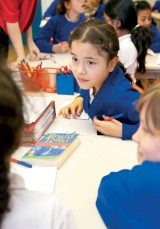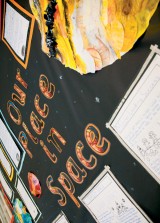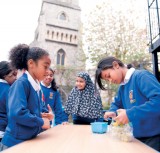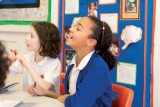Creating cross-curricular subject links can lead to rigid and uninspired planning, says Jonathan Lear. In contrast, an open-minded...
I don’t know about anyone else, but for me, you can’t beat a bit of educational reform. Given the 700 odd that were handed down to grateful schools over the last 15 years, I’m feeling a bit short changed at the moment. We never quite got there after the Rose review, thanks to that pesky election, but maybe now there is light at the end of the tunnel. Even as we speak, our esteemed leader, Mr Gove, is sat in Whitehall putting the finishing touches to his vision for education.
 Fortunately for the nation’s children, rather than waiting around, many schools have forged ahead with the development of their own versions of a 21st century curriculum. And regardless of what the new National Curriculum brings, schools will hopefully continue to ignore the nonsense, adapt what’s useful, and do what they know to be right for our children.
Fortunately for the nation’s children, rather than waiting around, many schools have forged ahead with the development of their own versions of a 21st century curriculum. And regardless of what the new National Curriculum brings, schools will hopefully continue to ignore the nonsense, adapt what’s useful, and do what they know to be right for our children.
Whenever we begin to redesign or look afresh at things, we inevitably focus on how all the different elements fit together. The original National Curriculum document had a front cover design made up of little coloured boxes that sat next to each other, but in isolation – a reflection of the separation of the different subjects. The curriculum that never was (the draft of which was created following Jim Rose’s recommendations in 2009) used a design based on coloured lines that flowed and crossed each other as they travelled across the cover. The intention was clear: making links and crossing boundaries is important. Now, whilst this thinking is not particularly ground breaking, the difference between schools that have embraced the opportunity to think creatively about their curriculum, and those that have simply gone through the motions, is huge. It seems the way in which a school views links and connections has a significant impact on the success of its curriculum.
 Most schools use crosscurricular links to connect different areas together. The aim of this is to produce a cohesive, joined up curriculum that makes the best use of the opportunities available.
Most schools use crosscurricular links to connect different areas together. The aim of this is to produce a cohesive, joined up curriculum that makes the best use of the opportunities available.
The connections made between different subjects then filter down to planning formats as the familiar cross-curricular links. Over the last 10 years, there have been several phrases or buzz words that, despite good intentions, havehampered our attempts to deliver the curriculum our children deserve. For my money, ‘crosscurricular links’ is right up there at the top. If I could, I’d do away with it completely. As a concept, it encourages us to make connections, but only within a closed, narrow field (National Curriculum subjects). English can be linked to history, music to maths, but don’t go mad; stick to the curriculum. This limited, convergent way of thinking wants us to remain inside the box. To achieve a genuinely creative curriculum, we need to adopt a more open, divergent model for curriculum design. To understand how this might work, we need to make a subtle shift in both our language and thinking. We need to forget about links and start using context.
The word ‘context’ is defined as ‘the situation within which something exists or happens.’ This idea is crucially important, largely because it is unashamedly vague. The word ‘situation’ could mean absolutely anything – it is not bound by the same constraints as a predetermined curriculum. Equally, it states that it is within this situation that ‘something’ happens.
Whilst there’s no doubt that cross-curricular links can provide great opportunities for learning, they are more to do with our creativity (or lack of it) than our children’s. The connections are made by us, the teachers, before the children even set foot in the classroom. They are based on the connections that we see and are frequently driven by the knowledge that we want to impart. We control the learning in the topic. But what if we embraced the vagueness? What if we let go of the reins a bit and took a step back? To explore this a little further, we’ll look at an area of the curriculum from both perspectives.
In its current state, the history curriculum for KS2 features the Tudors as part of the breadth of study. The QCA provided a scheme of work to accompany this area of the curriculum, and whilst many schools have moved away from rigidly following these units, they often remain a starting point for forming topics.
 What were the differences between the rich and poor people in Tudor Times?
What were the differences between the rich and poor people in Tudor Times?
Cross-curricular links: History, English, Drama, Art, ICT and Dance
In this example of a traditionally linked topic, the school has organised the curriculum to facilitate strong links between each of the different subjects. The main focus of the topic is the Tudors, with the other subjects being linked in accordingly. As a starting point, the children begin to learn the history bit; this could then be linked to art through exploring portraiture (Henry VIII). English could be linked in numerous different ways: drama, perhaps historical fiction, or diary writing. The children could also learn about Tudor dance (if you desperately wanted them to), and ICT could be linked at various points in the form of research, presentations or the use of digital media to film the dance or drama.
The nature and direction of the topic is clear from start to finish. It’s centred on a knowledge based history unit – we want the children to learn about the Tudors. The other areas of the curriculum are then linked to enhance the learning. It looks quite good, we know what we’re doing, and if we want to impart the knowledge associated with this period of history, then it’s certainly a more interesting approach than delivering the subjects in isolation.
If you’re feeling brave, however, you might be tempted to worry less about what the children know, and focus more on what they think.
 Rather than be drawn into planning a topic based on imparting knowledge about the Tudors, there is a much more tempting opportunity lying just beneath the surface. The subheading of the QCA unit asks a question about the difference between the rich and poor in Tudor times. Now that we’re thinking about context, our aim is to develop broad, open ended themes that form a starting point for the children’s learning. The idea of ‘rich and poor’, or ‘poverty and wealth’ seems to fit the bill perfectly. It’s powerful, vague, open to interpretation, full of possibility, and, as such, has the potential to be a much more effective starting point.
Rather than be drawn into planning a topic based on imparting knowledge about the Tudors, there is a much more tempting opportunity lying just beneath the surface. The subheading of the QCA unit asks a question about the difference between the rich and poor in Tudor times. Now that we’re thinking about context, our aim is to develop broad, open ended themes that form a starting point for the children’s learning. The idea of ‘rich and poor’, or ‘poverty and wealth’ seems to fit the bill perfectly. It’s powerful, vague, open to interpretation, full of possibility, and, as such, has the potential to be a much more effective starting point.
With our broad context decided upon, the next step is to begin the process of planning. It’s at this point that we really start to see the difference between the crosscurricular linked model and our context based theme. In planning the former, we start with the main subject and then think about what we could do in English, or art, or ICT that would link with this theme. We make sure that the topic fits into the required subject boxes and, when it’s complete, we tend not to deviate far from the plan. With context, the plan becomes a working document in which the big ideas come first. Our job is to ask as many ‘what ifs?’ as possible, and then see how we might use different subject areas to enable the ideas to be realised. As the topic develops, these adapt and change as the children supply their own ideas and lines of enquiry that are woven in as emergent objectives. (For more on this, look up ‘emergent curriculum’ on Wikipedia.)
 This approach requires a much greater degree of flexibility and openness on the part of the teacher. Rather than introducing the Tudors as before, the topic might begin with a circle time or Philosophy for Children session. How would the children respond to an image or object that represented the rich and poor – see left.
This approach requires a much greater degree of flexibility and openness on the part of the teacher. Rather than introducing the Tudors as before, the topic might begin with a circle time or Philosophy for Children session. How would the children respond to an image or object that represented the rich and poor – see left.
What questions would they ask? What do the children think rich and poor means? How much money do you need to be rich? Can you be rich if you have no money? Are all rich people happy? Are all poor people unhappy? What do they think about inequality? What do they know about inequality? How could they find out more?
In keeping with the previous linked unit, we would still maintain a historical aspect. What was life like for the rich and poor 50 years ago? 100 years ago? Or 500 years ago (during the Tudor period)? Rather than making the Tudors the main focus, it would form part of a broader historical study. When given the opportunity, children will often surpass our expectations in terms of learning. Why restrict them to a 120 year period when they might decide to explore the issues of wealth and poverty across several points in history.
Along with a study of the past, what about the future? What will the lives of the rich and poor be like in 10 years time? Is there anything we can do about it? Organisations such as CAFOD, UNICEF, or Oxfam strive to highlight inequality in developing countries, but how could we help? Instead of simply recognising inequality there’s the opportunity to empower children to take positive action.
In giving the children the opportunity to think for themselves, to question and explore, we discover opportunities for learning that we may never have considered. It doesn’t absolve us of our responsibility to deliver the curriculum, it does, however, change the way in which we approach this task. Our role as teacher becomes less about imparting knowledge, or working towards fixed outcomes, and more about facilitation and guidance. We might know our starting point, but we’re not really sure where things will end up. There will be times when we influence the children’s direction, and there will be times when we engage in direct teaching, but there will also be times when we stand back and watch as the children discover the power of learning for themselves.
With more space to think, both for ourselves and the children, the potential for enriching our curriculum is vast. Using a broad context allows unexpected things to grow and it is from this, in partnership with our children, that a truly great curriculum evolves.
Jonathan Lear is a Teaching Award winner and AST at St Catherine’s Catholic Primary School, Sheffield. To read more articles written by Jonathan, visit teachprimary.com and search the free resources section.
How to use Harry Potter to engage high-ability learners
Ace-Languages
